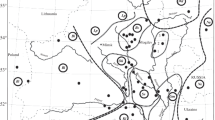Abstract
The phasmatid species Didymuria violescens comprises ten distinct chromosome races parapatrically distributed such that adjacent races meet in narrow zones of overlap. The interracial karyotypic variation is remarkable and involves both diploid number differences (in the range 26–40) and differences in the sex-chromosome mechanism. Karyotypic comparisons and analyses of the meiotic pairing relationships in interracial hybrids have shown that the differences derive in large part from a series of centric fusion events and X-autosome fusions, which together contribute to the reduction in chromosome number within the species. The origin and development of the current racial pattern can best be interpreted in terms of the stasipatric hypothesis of White.
Similar content being viewed by others
References
Craddock, E.M.: Chromosome number variation in a stick insect Didymuria violescens (Leach). Science 167, 1380–1382 (1970)
Craddock, E.M.: Cytological studies of the Australian Phasmatodea. Ph.D. Thesis, University of Sydney, Sydney, Australia (1971)
Craddock, E.M.: Chromosomal diversity in the Australian Phasmatodea. Aust. J. Zool. 20, 445–462 (1972)
Crocker, R.L., Wood, J.G.: Some historical influences on the development of the south Australian vegetation communities and their bearing on concepts and classifications in ecology. Trans. roy. Soc. S. Aust. 71, 91–136 (1947)
Darlington, C.D.: Recent advances in cytology. 2nd ed. London: J.A. Churchill Ltd. 1937
Darlington, C.D.: Evolution of genetic systems. 2nd ed. Edinburgh, London: Oliver and Boyd 1958
David, T.W.E.: Geology of the Commonwealth of Australia (W.R. Browne ed.). London: Arnold & Co. 1950
Essad, S., Arnoux, J., Maia, N.: Controle de validité des caryogrammes. Application au caryotype de Lolium perenne L. Chromosoma (Berl.) 20, 202–220 (1966)
Hadlington, P., Shipp, E.: Diapause and parthenogenesis in the eggs of three species of Phasmatodea. Proc. Linn. Soc. N.S.W. 86, 268–279 (1961)
Hughes-Schrader, S.: On the cytotaxonomy of phasmids (Phasmatidae). Chromosoma (Berl.) 10, 268–276 (1959)
Key, K.H.L.: The concept of stasipatric speciation. Systematic Zool. 17, 14–22 (1968)
Matthey, R.: L'évolution de la formule chromosomiale chez les vertébrés. Experientia (Basel) 1, 50–56, 78–86 (1945)
Patau, K.: The identification of individual chromosomes especially in man. Amer. J. Hum. Genet. 12, 250–276 (1960)
Patton, J. L.: Karyotypic variation in the pocket-mouse, Perognathus penicillatus Woodhouse (Rodentia: Heteromyidae). Caryologia (Firenze) 22, 351–358 (1969)
Patton, J.L., Dingman, R.E.: Chromosome studies of pocket gophers, Genus Thomomys. I. The specific status of Thomomys umbrinus (Richardson) in Arizona. J. Mammalogy 49, 1–13 (1968)
Patton, J.L., Dingman, R.E.: Chromosome studies of pocket gophers, genus Thomomys. II. Variation in T. bottae in the American southwest. Cytogenetics 9, 139–151 (1970)
Readshaw, J.L.: A theory of phasmatid outbreak release. Aust. J. Zool. 13, 475–490 (1965)
Shipp, E.: Rates of development in eggs from three populations of Didymuria violescens (Leach) (Phasmatodea). Proc. Linn. Soc. N.S.W. 88, 287–294 (1963)
Smith, H.M.: The perspective of species. Turtox News 33, 74–77 (1955)
Thaeler, C.S. Jr.: Karyotypes of sixteen populations of the Thomomys talpoides complex of pocket gophers (Rodentia-Geomyidae). Chromosoma (Berl.) 25, 172–183 (1968)
Tobgy, H.A.: A cytological study of Crepis fuliginosa and C. neglecta and their F1 hybrid, and its bearing on the mechanism of phylogenetic reduction in chromosome number. J. Genet. 45, 67–111 (1943)
White, M.J.D.: Models of speciation. Science 159, 1065–1070 (1968)
White, M.J.D.: Animal cytology and evolution. 3rd ed. London: Cambridge University Press 1973
White, M.J.D., Blackith, R.E., Blackith, R.M., Cheney, J.: Cytogenetics of the viatica group of morabine grasshoppers I. The “Coastal” species. Aust. J. Zool. 15, 263–302 (1967)
Wright, S.: Breeding structure of populations in relation to speciation. Amer. Naturalist 74, 232–248 (1940a)
Wright, S.: The statistical consequences of Mendelian heredity in relation to speciation. In: Huxley, J. The New Systematics, p. 161–183. Oxford: Clarendon Press 1940b
Wright, S.: On the probability of fixation of reciprocal translocations. Amer. Naturalist 75, 513–522 (1941)
Wright, S.: Isolation by distance under diverse systems of mating. Genetics 31, 39–59 (1946)
Author information
Authors and Affiliations
Additional information
This paper is affectionately dedicated to Professor Spencer Smith-White on the occasion of his 66th birthday.
Rights and permissions
About this article
Cite this article
Craddock, E.M. Intraspecific karyotypic differentiation in the Australian phasmatid Didymuria violescens (Leach). Chromosoma 53, 1–24 (1975). https://doi.org/10.1007/BF00329387
Received:
Issue Date:
DOI: https://doi.org/10.1007/BF00329387




